They are Northern Latitude –38.945 (-38° 56' 42" S), Southern Latitude -39.015 (-39° 0' 54"), Western Latitude 175.66 (175° 39' 35.9994" E), Eastern Latitude 175.79 (175° 47' 23.9994" E).
The maps below show the search areas as a darker shade.
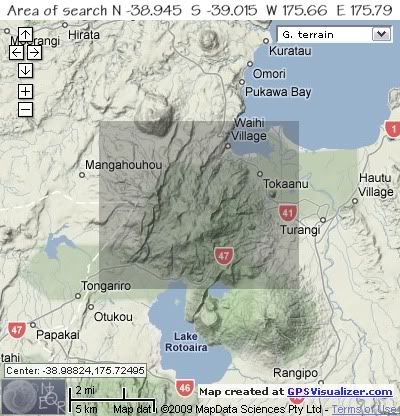
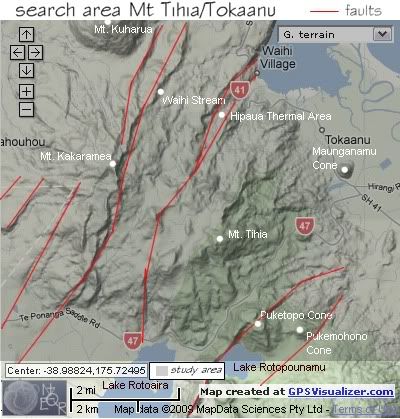
Geology
The Taupo Volcanic Zone lies above the sub-ducting Pacific Plate and is crossed by NE-NW trending faults of the Taupo Graben
Andesite magma occasionally wells up through some of these faults, resulting in chains of volcanic features parallel to the boundry plate.
An exception to the general trend are three old cones north of Lake Rotoaira; Mt. Pihanga, Mt. Tihia and Mt Kakaramea.
These 3 volcanoes relate to a pre-Taupo Graben plate boundry and associated faults which lay at right angles .( NW-SE)to the current ones (NE-SW)
The north-westerly trending Kakaramea-Tihia Massif and Pihanga form a chain of volcanoes which last erupted more than 20,000 years ago, but from which large mudflows have recurred up to as recently as 1910 A.D.
Of the other cones or domes in the area geologigal studies have shown that Papanetu Tephra was erupted from the site of Kuharua Dome c. 9,785 years ago towards the end of dome formation. Manganamu Dome is younger than 1819 years old.
Tokaanu–Waihi geothermal field is situated near the southern end of the Taupo Volcanic Zone. Neutral chloride thermal waters discharge at Tokaanu and Waihi in the north of the field on flat land between the andesite volcanoes Tihia and Kakaramea and the shore of Lake Taupo, while steam-heated thermal features occur at Hipaua on the northern flanks of Kakaramea. Electrical resistivity surveys have shown that Tokaanu, Waihi and Hipaua all lie within a continuous region of low apparent resistivity (5–20 Ωm) and are thus part of the same geothermal system. Interpretation of the resistivity and other data suggests that the Tokaanu–Waihi thermal waters rise nearly vertically from a source deep beneath the elevated southwestern part of the field to the water table. These waters then flow north to discharge at the surface near Lake Taupo. Neighbouring geothermal systems, which occur at Tongariro about 18 km south of Tokaanu–Waihi, and at Motuoapa about 10 km to the northeast, are separated from the Tokaanu–Waihi field by high resistivity ground. This suggests that the thermal fluids discharging at the three fields do not have a common source, as has been suggested previously.
The steaming ground area Hipaua is the 3rd largest of its kind in the TVZ and covers approx.1km2 of steep ground along the Waihi Fault.
Event Recording
Early earthquake activity in the southern Taupo Volcanic Zone was recorded with the national seismic network, then more so from 1966 onwards when a seismometer near Mt Ruapehu was incorporated in the network. The detectable number of swarms increased significantly when, in 1985, a sub-network around Lake Taupo was installed - the Taupo Network, which recorded events with a magnitude less than 2 ML. Prior to 1985, only events with ML greater than 3.0 had been recorded.
The Taupo Seismic Network was a network of six telemetred seismographs that operated around Lake Taupo between 1985 September and 1991 July.
The stations were;
KETZ at Ketetahi
RATZ at Rangitukua
HITZ at Hingarae
HATZ at Hinemaiaia
TUTZ at Tuhingamata
HUTZ at Hika Falls
They are now integrated into the WELT Network run by the Institute of Geological and Nuclear Sciences.
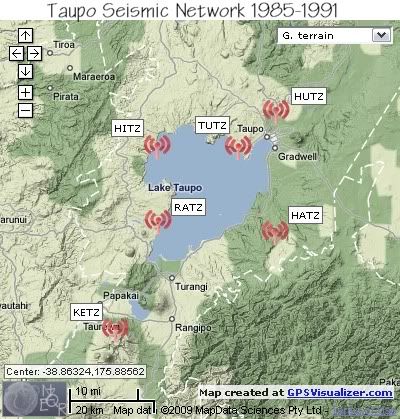
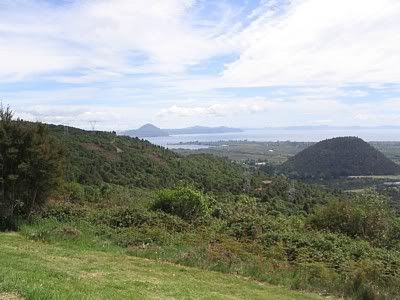
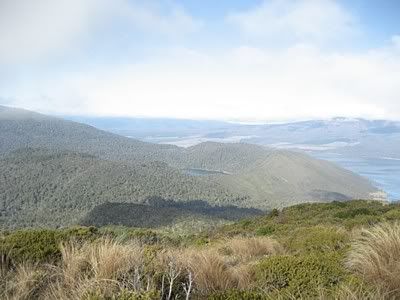

No comments:
Post a Comment